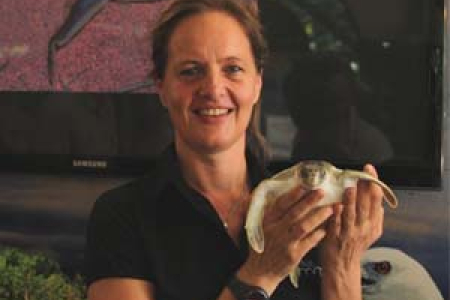Turtle day puts spotlight on research
A Charles Darwin University researcher is edging closer to helping provide vital information to protect threatened turtle species living in Top End waters and throughout the Arafura Sea.
CDU marine biodiversity Research Fellow with the North Australia Marine Research Alliance Dr Kiki Dethmers said World Turtle Day on May 23 was an opportunity to shine a spotlight on threats to turtles in the Northern Territory.
Dr Dethmers is working to provide valuable data for conservation and management efforts aimed at reducing detrimental impacts on Australasian sea turtle populations.
Focusing on the Arafura and Timor Seas, she is working with a network of collaborators to assess the impact of ghost nets on turtle populations in the region.
“A major threat to north Australian turtle populations is discarded fishing nets, commonly known as ghost nets,” Dr Dethmers said.
“We have been mapping the movement of ghost nets throughout the region for several years and have developed a model that gives us a good understanding of where ghost nets are most likely to occur in the different seasons.”
By tracking several Olive Ridley and Flatback turtles over the past two years using satellite telemetry, Dr Dethmers is also identifying their migratory pathways and areas where individual turtles like to spend most of their life-time looking for food.
“We are particularly interested in identifying the foraging areas for individual Olive Ridley turtles because they are among the most common species that we find in the ghost nets,” she said. “In Australia, this is the smallest of all sea turtle species, only nests in the north and we know relatively little about their biology.”
She said the outcomes of the research would provide authorities with information to aid with more targeted management of the ghost net issue.
“Using the information of the migratory patterns together with information about where nets drift could help predict potential hotspot areas for ghost net-turtle interaction.”
Dr Dethmers has also conducted genetics work to establish where the turtles found tangled in ghost nets originate from.
“We have estimated that 50 per cent are from Australian populations and 50 per cent are from neighbouring countries such as Indonesia and possibly from other, as yet unsampled areas such as Timor Leste, so it is something the whole region should be concerned about,” she said.
“Olive Ridleys are listed as endangered under the Environment Protection and Biodiversity Conservation Act and Flatback turtles are endemic to Australia so it is our responsibility to look after them.”
Together with the Crocodile Island Rangers, Dr Dethmers is tracking several species of turtles that nested on the Crocodile Islands, including three Olive Ridley turtles. Members of the public can follow the turtle’s progress by visiting the link: http://www.seaturtle.org/tracking/index.shtml?project_id=1016
